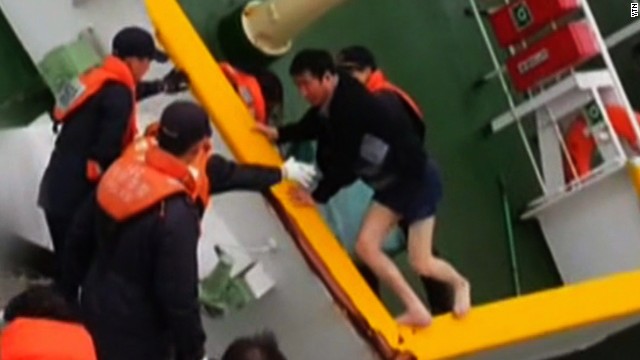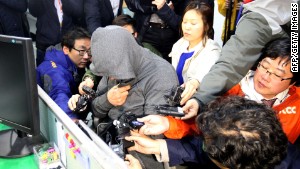April 29, 2014 -- Updated 1032 GMT (1832 HKT)

Sewol ferry Captain Lee Joon-seok being rescued
STORY HIGHLIGHTS
- Images of captain's rescue adds to anger in South Korea over ferry tragedy
- Captain's rescue happened while others were still in the sinking ship
- Actions of captain and crew are under the microscope
Editor's note: Andrew
Stevens is an award-winning CNN anchor and correspondent based in Hong
Kong. He is currently in South Korea. The opinions expressed in this
commentary are solely those of the author.
He was, in fact, among the first to be rescued.
The shock for me is not
this image itself, but the realization that Captain Lee Joon-seok must
have known as he got off the Sewol that hundreds of other passengers --
including 325 students -- were still inside, apparently following
instructions to stay put -- instructions that may be proven by
investigators to have led directly to their deaths.
On Monday, the South Korean coast guard released new footage of the captain and other crew members leaving the ship -- images that to me are equally disturbing.

Captain Lee appears at a media conference April 19.
The sea around the Sewol
looks glass-calm. It's bright morning light, there's no swell, there's
no obvious sign of tearing currents. For a body of water with such a
treacherous reputation, it looks benign. Perhaps not safe, but well
worth risking if your life is at stake.
At this point the Sewol is leaning dangerously, to the port or left side, its upper deck under water.
No one knows the vessel is close to beginning its final descent to the seabed.
But Captain Lee, wearing a
shirt and what looks like his underwear, and other crew members are
helped into a small rescue boat, leaving the passengers to their fate.
In cell phone footage taken by a teenage boy inside the Sewol --
also released in recent days -- students after being told effectively
to sit tight are seen patiently waiting for further instructions and for
help to arrive. A showing of faith and trust in authority that appears
now tragically misplaced.
None of the crew,
including the captain, identified themselves to rescuers as crew
members, the first coast guard responders said in a press conference on
Monday. Their uniforms -- if they were wearing them -- were hidden by
life vests.
This footage has only
added to already widespread public revulsion in South Korea around the
events surrounding the sinking of the Sewol.
A week ago, President Park Geun-hye described the crew's actions as being "like murder."
An aunt of one of the
student victims from Danwon High School told me how "ashamed" she was
that this could happen in South Korea. She is so upset, she just wants
to leave the country.
There are tales of heroism as well. The 22-year-old crew member Park Jee Young who died as she tried to help passengers to safety and handing out life vests. And of course there are the divers and rescue teams scouring the sunken vessel in extremely difficult conditions.
Perhaps these acts may
not have been necessary if more immediate and appropriate action had
been taken by the ship's commanding officers.
There's no international maritime law that says a captain has to go down with his or her ship. But there have been honorable examples of this course of action -- Captain Edward J. Smith of the Titanic comes to mind.
The captain is responsible for the vessel and all the people on board.
In some countries, including South Korea, abandoning ship is a maritime crime.
It's not just the
actions of Lee under the microscope here. It's also the shipping company
itself and government regulation. How were the crew trained to deal
with emergencies? How safe was the vessel? How well-regulated are South
Korea's coastal passenger ships? All are questions to which South
Koreans are demanding answers.
Yes, the captain and 14
other Sewol crew members have been arrested amid ongoing investigations.
They all face charges of "causing death by abandoning (ship), and
violation of the country's marine law, the Rescue and Aid at Sea and in
the River Act," Yang Joong-Jin, the senior prosecutor for the
investigation task force says.
At this stage though, it is the actions and the images of the captain that stand out -- at least for me.
The image of a man who
for many, if not legally but certainly at least morally, is responsible
for his passengers, seemingly putting himself before everyone else.
http://edition.cnn.com/2014/04/29/world/asia/south-korea-captain-video-stevens/index.html?hpt=hp_c2

Comments